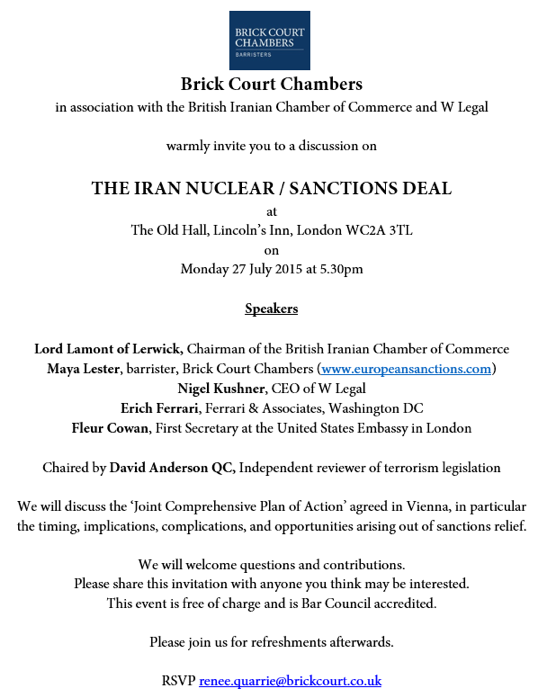How Preserving the Sanctions Architecture Informed Iran Sanctions Relief
In designing the Joint Plan of Action, which set the stage for the U.S.-Iran negotiations that would culminate in the Joint Comprehensive Plan of Action some 18 months later, one of the fundamental policies of the Obama administration was to structure sanctions relief “so that the overwhelming majority of the sanctions regime, including the key oil, banking, and financial sanctions architecture, remains in place.” In taking action to implement this policy goal, U.S. Treasury officials ran into little difficulty, as U.S. sanctions relief under the JPOA was slight in scope and insignificant in impact.
What is interesting, however, is to consider how this policy has been carried over to the Joint Comprehensive Plan of Action (i.e., the finalized nuclear deal). Preserving the sanctions architecture was an important goal at a time when it remained unclear whether or not the U.S. and Iran would be able to come to an agreement. To a great extent, it remains so, especially insofar as the Obama administration argues that the U.S. could ‘snapback’ sanctions on Iran should Iran stand in violation of its JCPOA commitments. As such, it is no surprise that a close review of the JCPOA’s text reveals that preserving the sanctions architecture remained a guiding concern for Treasury officials involved in negotiating Iran’s sanctions relief under the deal.
The best place to evidence this concern lies with Section 104(c) of the Comprehensive Iran Sanctions, Accountability, and Divestment Act (“CISADA”). Section 104(c) of CISADA is sometimes referred to as the backbone of the Iran sanctions regime – the starting point from which U.S. sanctions kicked into high gear. As the former Under Secretary for Terrorism and Financial Intelligence, David S. Cohen, said during remarks delivered to NYU Law students in 2012, CISADA Section 104(c) “set a new precedent,” giving “the Secretary of the Treasury the authority for the first time to require U.S. banks to terminate correspondent banking relationships with foreign banks that knowingly engaged in significant transactions with designated Iranian banks.” Section 104(c) of CISADA, in the words of the former Under Secretary, “offered foreign banks a choice: they could do business with banks in the U.S., or they could do business with designated Iranian banks. But they could not do both.”
Under Section 104(c) of CISADA, foreign banks are targeted for sanctions, which involves their exclusion from the U.S. financial system, if they engage in one of the following sanctionable activities:
- Facilitate the efforts of the Government of Iran to acquire or develop WMD or delivery systems for WMD, or provide support for foreign terrorist organizations or support for acts of international terrorism;
- Facilitate the activities of a person subject to financial sanctions under any one of the Iran-related United Nations Security Council resolutions;
- Engage in money laundering to carry out one of the above activities;
- Facilitate efforts by Iran’s Central Bank or any other financial institution to carry out the activities enumerated above;
- Facilitate a significant transaction(s) or provide significant financial services for Iran’s Revolutionary Guard Corps or any of its agents or affiliates whose property is blocked under IEEPA, or a financial institution whose property is blocked under IEEPA in connection with Iran’s WMD proliferation or delivery systems (i.e., EO 13382) or Iran’s support for international terrorism (i.e., EO 13224)
What, then, does the JCPOA do to these extensive prohibitions?
Nothing, really.
One of the great things of Annex II to the JCPOA, which outlines the sanctions relief under the nuclear deal, is the inclusion of citations to those statutory provisions and Executive Orders that will be affected by the sanctions-lifting. This level of detail allows us not just a keen understanding of what sanctions relief will look like, but also gives us a peek into how U.S. Treasury officials conceptualized sanctions relief itself.
So far as I can tell after reading Annex II over several times, CISADA Section 104(c) appears once, in § 4.1.1 of Annex II to the JCPOA. There, 104(c)(2)(E)(ii)(I), which corresponds to the relief of sanctions on Iranian financial institutions designated under Executive Order 13382, is intended to signal the lifting of restrictions on transactions with certain designated Iranian individuals and entities. Outside of this single cite to a specific subsection, CISADA Section 104(c) is left unmentioned in the JCPOA.
This is not terribly surprising, considering that CISADA Section 104(c) targets either Iranian activities above and beyond the nuclear issue or nuclear-related activities that are directly related to nuclear weapons development. Nonetheless, what it does to those provisions of Section 104(c) that are related to the nuclear issue is most fascinating.
Realizing that most of CISADA Section 104(c) will be left un-tampered with during the course of the nuclear deal, the next question, then, is to consider how the President will relieve the sanctions outlined at Section 104(c)(2)(E)(ii)(I). In my view, there are two ways to do it:
- the President utilizes a limited statutory waiver of the sanction, so that its application is suspended during the course of the JCPOA; or
- the President delists those Iranian financial institutions that were subject to sanctions under Executive Order 13382.
But because we know that most of the Iranian banks designated under Executive Order 13382 will be delisted (courtesy of Attachment 3 to the JCPOA), we can make the reasonable assumption that OFAC will choose the latter course: the U.S. will delist those Iranian banks that were subject to the sanctions at CISADA Section 104(c)(2)(E)(ii)(I), while leaving intact the application of the sanctions provision.
In other words, no waiver and no suspension: Section 104(c) of CISADA will remain as applicable under the nuclear deal as prior to the JCPOA. That’s one easy way to keep the sanctions architecture firmly in place!
But the larger point is not just how detailed the sanctions relief is, but also how the manner in which the U.S. is relieving sanctions is deeply informed by the desire to keep intact what is called the “sanctions architecture.” Section 104(c) of CISADA is a single, if illuminating, example of this. By relying so heavily on the delisting of Iranian entities and individuals in order to exact sanctions relief, Treasury officials were able to leave intact the application of U.S. sanctions by limiting those instances in which the President is required to utilize his waiver authorities. This is something of an ingenious solution, especially in light of the fact that few predicted beforehand that the U.S. would delist as many Iranian entities and individuals and as quickly as is required under the JCPOA.
In some ways, then, the U.S. will be heavily reliant on its sanctions designation programs to snapback sanctions should Iran violate the terms of the deal. Considering the manner in which OFAC’s SDN List has been incorporated into the compliance programs of U.S. and foreign parties conducting international business, this reliance is not misplaced. Find Iran to be in “significant non-performance” of its obligations under the JCPOA, then designate certain Iranian banks conducting transactions on behalf of Iran’s nuclear program and their designation will register as ‘hits’ the next morning for all transactions in which foreign parties are engaged. That’ll make quick work of snapback sanctions.



